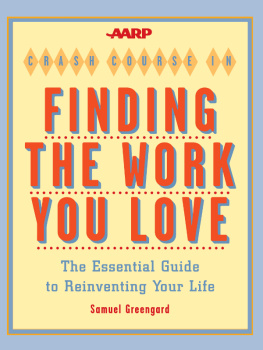
THE AARP CRASH COURSE IN
FINDING THE WORK
YOU LOVE
THE ESSENTIAL GUIDE TO
REINVENTING YOUR LIFE
BY SAMUEL GREENGARD

AARP Books publishes a wide range of titles on health, personal finance, lifestyle, and other subjects that promise to enrich the lives of older Americans. For more information, go to www.aarp.org/books. For information on changing careers, go to recareering-guide.com.
AARP, established in 1958, is a nonprofit organization with more than 39 million members age 50 and older.
The AARP name and logo are registered trademarks of AARP, used under license to Sterling Publishing Co., Inc.
The recommendations and opinions expressed herein are those of the author and do not necessarily reflect the views of AARP.
STERLING and the distinctive Sterling logo are registered trademarks of Sterling Publishing Co., Inc.
10 9 8 7 6 5 4 3 2 1
AARP 2008
Published by Sterling Publishing Co., Inc.
387 Park Avenue South, New York, NY 10016
Distributed in Canada by Sterling Publishing
c/o Canadian Manda Group, 165 Dufferin Street
Toronto, Ontario, Canada M6K 3H6
Distributed in the United Kingdom by GMC Distribution Services
Castle Place, 166 High Street, Lewes, East Sussex, England BN7 1XU
Distributed in Australia by Capricorn Link (Australia) Pty. Ltd.
P.O. Box 704, Windsor, NSW 2756, Australia
Manufactured in the United States of America
All rights reserved
Sterling ISBN 978-1-4027-5240-7
For information about custom editions, special sales, premium and corporate purchases, please contact Sterling Special Sales Department at 800-805-5489 or specialsales@sterlingpublishing.com.
To my mother, Marcia S.G.
CONTENTS

SECTION I:
MAKING SENSE OF TODAYS WORKING WORLD
Chapter 1: A New Attitude
Chapter 2: Navigating the World of Work
Chapter 3: Are You Ready to Change Careers?

SECTION II:
FINDING YOUR RAINBOW
Chapter 4: What Is Your Recareering Style?
Chapter 5: Discovering Your Ideal Career
Chapter 6: What Are My Options?

SECTION III:
BUILDING A FOUNDATION FOR YOUR FUTURE
Chapter 7: Back to School, Forward to Work
Chapter 8: Money Matters
Key Questions
Chapter 9: A Question of Balance
Chapter 10: Higher Callings

SECTION IV:
PUTTING YOUR PLAN INTO ACTION
Chapter 11: A Tool Kit for Trading Places
Chapter 12: Make Your Presence Known
Chapter 13: Mastering the Art of the Interview
Chapter 14: Youve Changed Careers: Now What?
Worksheet: Discovering Your Style
ASK A CHILD what she wants to be when she grows up and youre likely to get an earful: anything and everything from doctor to toy maker, astronaut to veterinarian. Thats because kidsand the parents, teachers, and family members who raise thempromote the concept of dreaming and exploring. Thankfully, these youthful minds havent yet encountered the immobilizing gravity of I cant do that! or What would my friends think? There are no mental boundaries or limitations, only possibilities.
Fast-forward a couple of decades, and most of us find ourselves plowing through a heaping dose of reality. We need to support our families and ourselves. We want to show our parents, siblings, and friends that we are faring well. And we would dearly love to plan for a retirement period that becomes more elusive with each passing decade.
Having worked so hard to get where we are, making any sort of departure from that spoteven if its to pursue our dreamslooms as a scary and uncertain proposition.
Not until middle age do many of us gain the perspective and wisdom needed to recognize, amid all that noise, the signals to which we are truly attuned. The professional path we selected (or were shunted into) at age 25, we realize, now differs radically from the one we would choose from scratch at 50. At this stage of life, however, with the clock inexorably ticking, achieving life goals and leaving a legacy assume a new sense of urgency.
Fortunately, its also at this point that were finally able to dream like childrenwhile putting a lifetime of knowledge and experience to work. Were finally ready to reinvent ourselves. And were in a position to enjoy the fruits of that redefinition more than at any other time in our past.
To be sure, summoning the courage and resources to change careers (or to embark on a new path in an existing career) demands fortitude, patience, and poise. Along the way, we may question our own thinking and desires. We may harbor misgivings about our ability to go back to school, learn new skills, and venture into an entirely new field. Worse yet, others may encourage us in the doubt department.
It may help to view such qualms as the occupational hazards of reinventing ones life. Faced with the enormityand noveltyof switching careers, its tempting to second-guess yourself: Why am I tossing so much away? My education and training, my professional stature and hard-won salary, my office with a doorgoodbye to all that?
In actuality, the opportunity to recharge ones batteries can be a special gift. Were able to grow and put our talents to work. If were fortunate, we can make a tangible impact on the world.
Finding the work you love neednt be an abstract undertaking. Whether youre 40 or 60whether youve toiled in the trenches of bureaucracy or blazed an entrepreneurial trailits best to obey the recareering urge when it strikes. Growth, after all, is the one sure antidote to stagnation.
A first foray into career change. I feel fortunate to have learned this lesson relatively early in my life. In junior high school, a talented teacher named Mrs. Lewis helped bring my imagination to the surface in her creative-writing class. As I began churning out short stories, I discovered that I genuinely enjoyed the magic of putting thoughts into words, then arranging them in patterns that communicated messages. It was a special act that guided me through some difficult emotional times. I enjoyed writing for the pureness of doing something I truly loved. You may have experienced the same sensation sewing, cooking, or building model airplanes.
During high school and college, I worked part-time at an amusement park in Southern California. I started out as a busboy in the mid-1970s, earning less than $2 per hour. Over the next six years I steadily climbed the company ladder, working successively as a cashier, food preparer, cook, supervisor, restaurant manager, and finally area manager. In the end, I oversaw five restaurants with more than 100 employees and close to $5 million in annual revenues.
Not surprisingly, the business world beckoned.
So, after graduating from college in 1979, I accepted an offer to manage a restaurant. A year later, weary of the long hours, high turnover, and constant headaches, I landed a management position at one of the Baby Bells. I bought the compulsory suits, learned the ropes of the business, and found myself pulling down $80,000 a year. My parents told me how proud they were. My friends congratulated me on my success. I feltand actedas though I had arrived.
Next page











